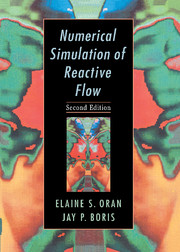Book contents
- Frontmatter
- Contents
- Prologue
- 1 An Overview of Numerical Simulation
- 2 The Reactive-Flow Modeling Problem
- 3 Models and Simulation
- 4 Some General Numerical Considerations
- 5 Ordinary Differential Equations: Reaction Mechanisms and Other Local Phenomena
- 6 Representations, Resolution, and Grids
- 7 Diffusive Transport Processes
- 8 Computational Fluid Dynamics: Continuity Equations
- 9 Computational Fluid Dynamics: Using More Flow Physics
- 10 Boundaries, Interfaces, and Implicit Algorithms
- 11 Coupling Models of Reactive-Flow Processes
- 12 Turbulent Reactive Flows
- 13 Radiation Transport and Reactive Flows
- Index
2 - The Reactive-Flow Modeling Problem
Published online by Cambridge University Press: 09 October 2009
- Frontmatter
- Contents
- Prologue
- 1 An Overview of Numerical Simulation
- 2 The Reactive-Flow Modeling Problem
- 3 Models and Simulation
- 4 Some General Numerical Considerations
- 5 Ordinary Differential Equations: Reaction Mechanisms and Other Local Phenomena
- 6 Representations, Resolution, and Grids
- 7 Diffusive Transport Processes
- 8 Computational Fluid Dynamics: Continuity Equations
- 9 Computational Fluid Dynamics: Using More Flow Physics
- 10 Boundaries, Interfaces, and Implicit Algorithms
- 11 Coupling Models of Reactive-Flow Processes
- 12 Turbulent Reactive Flows
- 13 Radiation Transport and Reactive Flows
- Index
Summary
As described in the previous chapter, the term reactive flow applies to a very broad range of physical phenomena. In some cases the equations are not even rigorously known. In this chapter, we first consider the equations of gas-phase reactive flows, which are generally accepted as valid in the continuum regime. This set of time-dependent, coupled, partial differential equations governs the conservation of mass and species density, momentum, and energy. The equations describe the convective motion of the fluid, reactions among the constituent species that may change the molecular composition, and other transport processes such as thermal conduction, molecular diffusion, and radiation transport. Many different situations are described by these equations when they are combined with various initial and boundary conditions. In a later section of this chapter, we discuss interactions among these processes and generalizations of this set of equations to describe multiphase reactive flows.
The material presented in this chapter is somewhat condensed, and is not meant to give an in-depth explanation to those unfamiliar with the individual topics. The purpose is to present the reactive-flow equations, to establish the notation used throughout this book, and then to relate each term in the equations to physical processes important in reactive flows. The chapter can then be used as a reference for the more detailed discussions of numerical methods in subsequent chapters. It would be reasonable to skim this chapter the first time through the book, and then to refer back to it as needed.
- Type
- Chapter
- Information
- Numerical Simulation of Reactive Flow , pp. 15 - 39Publisher: Cambridge University PressPrint publication year: 2000
- 1
- Cited by



